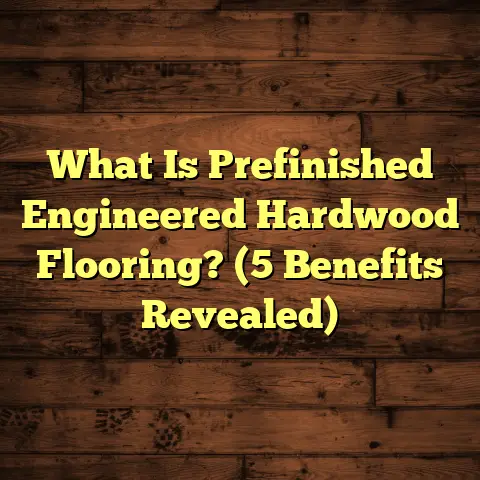What is Cheaper: Hardwood, Laminate, or Tile Flooring? (5 Cost Factors to Consider)
Cost-effectiveness is always at the forefront of my mind when tackling flooring projects with clients or friends. Floors cover a large surface area and can make or break a home’s look and feel — but they can also be a major financial commitment. I get asked all the time: “What’s cheaper — hardwood, laminate, or tile flooring?” It’s a great question, and the answer isn’t as straightforward as simply comparing sticker prices. Over the years, I’ve gathered data, learned from hands-on experience, and used various tools to help break down all the costs involved in flooring choices. I want to share that with you today.
Flooring might seem like just a surface beneath your feet, but it’s actually a complex decision involving materials science, installation skill, maintenance habits, and long-term durability. The goal here is to give you a clear picture of the real costs behind hardwood, laminate, and tile flooring—so you can make a choice that fits your budget and lifestyle.
What Is Cheaper: Hardwood, Laminate, or Tile Flooring?
Before jumping into prices, I think it’s useful to explain what each of these flooring types really are. Understanding their makeup and how they’re made gives insight into why costs vary so much.
Hardwood Flooring: The Real Wood Classic
Hardwood flooring is exactly what it sounds like — floors made from solid wood planks or engineered wood layers topped with a real wood veneer. When I say “solid hardwood,” I mean planks milled from a single piece of timber. Species like oak, maple, hickory, and walnut are common choices. These planks are typically 3/4 inch thick and can be sanded and refinished multiple times during their lifespan.
Engineered hardwood, which has become popular over the last few decades, is constructed differently. It consists of several layers of plywood or high-density fiberboard stacked and glued together in cross-grain layers for stability. The top layer is a thin slice of genuine hardwood (usually 2-6 mm thick). Engineered hardwood handles moisture fluctuations better than solid wood and can be installed over concrete or radiant heating systems.
Manufacturing Process
For solid hardwood, the process starts with selecting logs from forests sustainably managed in many cases today. The logs are cut into boards through a process called milling, where they are then dried in kilns to reduce moisture content to about 6-8%. This drying reduces warping and cracking after installation. Next, planks are planed smooth and sometimes pre-finished with stains or sealants.
Engineered hardwood manufacturing involves layering thin sheets of wood veneer with adhesives under high heat and pressure to create a stable core. The top veneer is sliced from premium hardwood species for aesthetics.
Because solid hardwood uses more natural timber and requires longer drying and finishing times, it tends to cost more than engineered versions.
Laminate Flooring: The Affordable Wood Look-Alike
Laminate flooring is a multi-layer synthetic product designed to imitate the look of wood or stone at a fraction of the price. It has a core made from medium-density fiberboard (MDF) or high-density fiberboard (HDF), which is essentially compressed wood fibers combined with resin.
On top of this core lies a high-resolution photographic layer that mimics wood grain or tile patterns. The surface is then covered by a protective melamine resin layer that makes it resistant to scratches, fading, and moisture.
How Laminate Is Made
The manufacturing process for laminate is highly industrialized. First, wood fibers are mixed with resins and compressed into dense boards under heat and pressure. Then the photographic layer is printed using advanced imaging technology to replicate natural textures precisely.
The protective top layer is crucial in giving laminate its durability against everyday wear and tear. Because laminate isn’t made from whole wood planks but rather engineered composites, it can be mass-produced very cost-effectively.
Tile Flooring: Clay Transformed by Fire
Tile flooring usually means ceramic or porcelain tiles made from natural clay combined with other minerals like quartz or feldspar. The raw materials are ground into powder, mixed with water to create a malleable paste, then shaped into tiles by pressing or extrusion methods.
After shaping, tiles are dried then fired in kilns at extremely high temperatures—ceramic tiles around 1,100 °C (2,000 °F) and porcelain tiles at even higher temperatures (up to 1,400 °C). This firing process vitrifies the clay body making porcelain denser and less porous than ceramic.
Tiles often come glazed — a thin glassy coating that adds color and texture while making them easier to clean.
Technical Specs That Influence Cost
- Porcelain tiles: Denser, harder, water-resistant; often recommended for high-traffic or wet areas.
- Ceramic tiles: Slightly more porous and softer; generally less expensive but still durable.
- Size variation: Larger format tiles cost more per piece but reduce grout lines.
- Thickness: Standard tile thickness ranges from 6mm to 12mm; thicker tiles tend to be pricier.
5 Cost Factors That Shape Flooring Budgets
Now let’s get into the nitty-gritty of what really drives costs when choosing between hardwood, laminate, or tile floors.
1. Material Price per Square Foot
Material cost is your starting point and varies widely across these options.
- Hardwood: Solid hardwood typically costs between $5 and $15 per square foot just for materials, depending on species and grade. Exotic woods like Brazilian cherry or walnut command higher prices than domestic oak or maple.
- Engineered hardwood tends to be slightly cheaper than solid hardwood but still ranges mostly between $4 and $10 per square foot.
- Laminate flooring offers the lowest material cost among these three—usually between $1 and $5 per square foot depending on thickness and brand reputation.
- Tile prices vary depending on type: ceramic tiles usually cost $1 to $3 per square foot while porcelain tiles range from $3 to $10 or more.
Here’s an example from my own experience: For a mid-range kitchen renovation project involving 300 sq ft of floor space, material costs were roughly $2,700 for engineered hardwood versus just about $900 for laminate flooring of similar style. Tile was around $2,000 for high-quality porcelain options.
2. Installation Costs
Installation is often where flooring budgets surprise people because labor can be just as expensive as materials.
- Hardwood installation requires expertise — planks need acclimating (to adjust moisture levels), precise nailing or gluing techniques, sanding (for unfinished wood), and multiple coats of finish. Labor cost typically runs between $4 to $8 per square foot.
- Laminate installation is simpler due to its click-lock design; many homeowners install it themselves. Professional installation usually costs $2-$5 per square foot.
- Tile installation is labor-intensive — requiring surface preparation, mortar setting, precise tile cutting (especially around corners), grouting, sealing, and cleanup. Labor costs here typically range from $5 to $10 per square foot.
I recall one job where tile installation took longer than expected because the existing floor needed leveling before tiles could be laid properly. That unexpected prep added almost 20% more labor cost.
3. Longevity and Maintenance Costs
How long flooring lasts affects its overall value.
- Hardwood floors are durable and can last over 50 years if well-maintained. Solid hardwood can be sanded and refinished multiple times; engineered hardwood less so but still extendable.
- Laminate floors usually have lifespans of 10-25 years but cannot be refinished if damaged; they require full replacement.
- Tile floors can last 30+ years with proper care due to their hardness but grout lines require periodic cleaning or resealing.
When I installed hardwood in my living room 15 years ago, I had it refinished twice already — extending its life far beyond initial expectations. Meanwhile, laminate I installed in a rental property lasted about 12 years before showing wear.
4. Waste Factor & Sizing Considerations
Material waste adds hidden costs.
- Hardwood planks come in fixed lengths/widths; cutting waste usually adds 5-10% extra material needed.
- Laminate planks are uniform but still require overage for mistakes or pattern alignment — about 5%.
- Tiles require precise cutting for edges and corners; waste can reach 10-15%.
I often advise clients to order slightly more material than exact area calculations suggest—especially for irregular room shapes—to avoid running short mid-job.
5. Regional Labor Rates & Material Availability
Geography affects cost too.
Urban areas with many contractors often have competitive labor rates; rural areas might see premiums due to fewer professionals.
Material availability also matters — exotic hardwoods might incur import fees in some regions; certain tile styles may not be locally stocked requiring shipping fees.
For instance, where I live in the Northeast US, hardwood installation averages $6/sq ft labor but colleagues on the West Coast report as high as $8/sq ft due to demand and union wages.
Diving Deeper Into Technical Specs & Manufacturing Insights
Let me share some details that often surprise people about these floorings’ technical sides.
Hardwood Durability & Grades
Hardwood species vary widely in hardness measured by the Janka scale (a test of resistance to denting):
| Species | Janka Hardness (lbs) |
|---|---|
| Red Oak | 1,290 |
| Hard Maple | 1,450 |
| Hickory | 1,820 |
| Brazilian Cherry | 2,350 |
Hardwoods on the higher end cost more but resist dents better — useful for busy households with pets or kids.
Grades also affect price:
- Clear grade: Minimal knots/defects; premium price.
- Select grade: Some natural markings allowed.
- Character grade: Knots/color variations allowed; rustic look at lower cost.
Laminate Thickness & Wear Layers
Laminate floorboards come in thicknesses from about 6mm up to 12mm+.
Thicker boards generally feel more solid underfoot but cost more.
The wear layer thickness (melamine resin) determines scratch resistance:
- Commercial grade laminate has thicker wear layers (0.5mm+) for heavy traffic areas.
- Residential grade may have thinner layers (0.2-0.3mm).
Tile Porosity & PEI Ratings
Porcelain tiles are less porous (<0.5%) making them suitable for wet areas.
Tiles have PEI ratings indicating abrasion resistance:
| PEI Rating | Use Case |
|---|---|
| PEI I | Wall tile only |
| PEI II | Light residential traffic |
| PEI III | Moderate residential traffic |
| PEI IV | Heavy residential/light commercial |
| PEI V | Heavy commercial traffic |
Higher PEI ratings mean higher tile costs but better durability.
Personal Stories That Show Cost Differences in Action
I remember one time helping a couple decide on flooring for their new home addition. They loved the look of solid oak hardwood but were hesitant about price.
We compared costs side-by-side using FloorTally — an online tool I use regularly that pulls local material prices and labor rates into one place for fast estimates.
FloorTally showed:
- Oak hardwood material + install: ~$12k
- Mid-grade laminate + install: ~$4k
- Porcelain tile + install: ~$7k
They decided on engineered hardwood as a compromise — better aesthetics than laminate but less expensive than solid oak.
For another project — a bathroom renovation — ceramic tile was an easy choice due to water resistance despite higher labor cost compared to vinyl options they initially considered.
How FloorTally Helps Me Manage Flooring Budgets
I’ve used various tools over the years for budgeting floors — but FloorTally stands out because it combines local pricing data with customizable waste factors and installation types in an easy interface.
It saves me hours because:
- I input room dimensions once;
- Choose flooring type;
- Adjust waste factor based on room complexity;
- Get instant realistic total cost estimates including labor;
- Compare different materials side-by-side instantly;
- Share detailed estimates with clients or family members without confusion;
On one job recently in my own home office remodel, FloorTally helped me quickly realize that upgrading from laminate to engineered hardwood would only add about $800 to my budget but increase lifespan significantly — easy decision after having clear numbers upfront.
A More Detailed Cost Breakdown Example
Let’s look at a hypothetical project breaking down actual numbers for a 1000 sq ft living room:
| Flooring Type | Material Cost/sq ft | Installation Cost/sq ft | Waste (%) | Total Material Cost | Total Install Cost | Total Cost |
|---|---|---|---|---|---|---|
| Solid Hardwood (Oak) | $8 | $6 | 10% | $8,800 | $6,600 | $15,400 |
| Engineered Hardwood | $6 | $5 | 8% | $6,480 | $5,000 | $11,480 |
| Laminate (mid-range) | $2 | $3 | 5% | $2,100 | $3,150 | $5,250 |
| Ceramic Tile | $3 | $7 | 10% | $3,300 | $7,700 | $11,000 |
| Porcelain Tile | $6 | $8 | 10% | $6,600 | $8,800 | $15,400 |
This example illustrates how installation costs can nearly double material expenses depending on the type of floor chosen.
Other Costs That Often Get Overlooked
People tend to forget these additional expenses that add to total flooring costs:
Subfloor Preparation
Uneven or damaged subfloors must be repaired or leveled before installing hardwood or tile — adding several hundred or thousands in some cases.
I recall one job where subfloor leveling added nearly $2/sq ft extra because old plywood was warped beyond usable limits.
Underlayment Materials
Underlayment improves comfort and moisture resistance:
- Foam underlayments ($0.30-$0.50/sq ft) commonly used under laminate.
- Cork or rubber underlayments costing more ($1-$3/sq ft) improve soundproofing.
- Cement backer boards ($1-$2/sq ft) often required under tile installations especially over wood subfloors.
Finishing & Sealing Costs
Unfinished solid hardwood floors require sanding and multiple coats of polyurethane finish ($2-$4/sq ft).
Grout sealing for tile floors adds maintenance costs every few years ($0.50-$1/sq ft).
Which Flooring Type Offers the Best Value?
Value isn’t always about picking the cheapest upfront price but balancing cost with durability and style preferences.
Here’s what I’ve learned over time:
- If budget is tight: Laminate is hard to beat for initial affordability especially if you want a wood look without spending thousands.
- If you want investment longevity: Hardwood floors repay their upfront cost over decades through refinishing ability.
- If moisture resistance is key: Tile shines in bathrooms/kitchens though installation costs are higher.
Choosing quality materials from reputable brands also saves money long-term by reducing replacement frequency.
Final Thoughts From My Flooring Workbench
I hope sharing both data points and stories helps you get clarity on what affects flooring costs most.
I encourage homeowners not just to think about price per square foot but total cost including installation, maintenance, lifespan, plus personal style goals.
If you want help running numbers for your project using tools like FloorTally or want expert advice tailored to your space specifics — just reach out! Happy flooring shopping!





